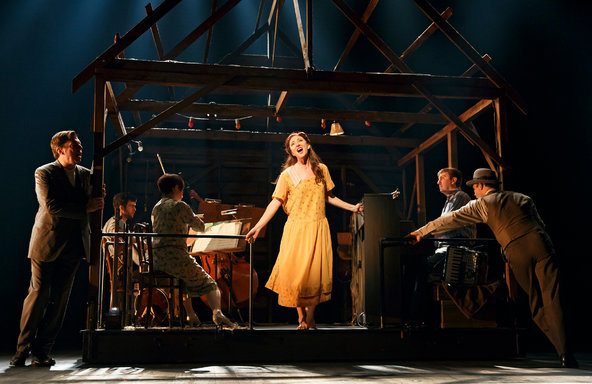

During a Broadway season that has been so praised for its diversity in terms of racial equality, Bright Star, sticks out like the sorest of thumbs, as it presents a portrait of utter whiteness that is almost blindingly bright to behold. Set in the North Carolina of the 1920s and 1940s, it fails to show a single character of color onstage. To borrow and add from the iconic Emcee of Cabaret, “even the orchestra is white”. The problem isn’t merely the show’s tone deaf approach to portraying life in the South without characters of color, in fact the creators could very well argue they were attempting to create a “nostalgia spectacle” the kind of which was popular on the stage during the 20s and 40s. Even then though, they would have had to include characters of color in smaller roles, like they did in Hollywood movies of the era which saw them play service staff or musicians. Not a very progressive thing to show onstage in 2016, but at least it could’ve been “defended” under paying tribute to the era.
The problem with Bright Star is that the plot is so disjointed, thin and flat out unconvincing, that we sit in the dark distracted by “external” elements, which in a better crafted show we would’ve discovered only during the post-theatre examination (they would’ve still been wrong then for the record…). The plot is centered on the “incredible” story of Alice Murphy (Carmen Cusack), a country girl with a rebellious spirit who in the 1920s begins an affair with the son (Paul Alexander Nolan) of the town mayor (Michael Mulheren) who will do anything in his power to keep them apart. The story is split between Alice in the 20s and a more successful version of herself working as a jaded magazine editor in the 1940s. The show then is meant to make us wonder what made the free spirited, joyous girl turn into a cynical His Girl Friday type.
If the paths that led her to where she is are rather limited in terms of dramatic anticipation (your first guess is correct, just add a clumsy Biblical twist to make it seem more original), what must be praised is Cusack’s ability to elevate such a wreck and make it seem almost good. In her Broadway debut, Cusack gives the kind of performance that inevitably makes us wonder: where has Carmen Cusack been all this time? With a sweet voice, a spunky personality and the ability to sell us on the improbable twists concocted by book writer Steve Martin (who co-wrote the music for the show with Edie Brickell, who wrote the lyrics), Cusack’s performance has a sincerity similar to classic Hollywood heroines like Olivia de Havilland and Jennifer Jones. We believe she ages decades with minimal makeup, we ache with her as she mourns lost love, and we can’t help but be thrilled whenever something good comes her way.
The show is directed by Walter Bobbie who doesn’t get to do much with the plot, and stages some rather clumsy romantic scenes between characters played by supporting players A.J. Shively and Hannah Elless, who keep popping up to take us away from Alice’s story. We know that they have larger parts to play - otherwise why have them onstage as often - but their scenes feel intrusive. Jeff Blumenkrantz and the delicious Emily Padgett fare much better as comedic sidekicks who know their place and squeeze their time on the spotlight without pausing the show.